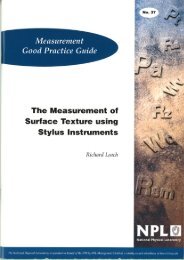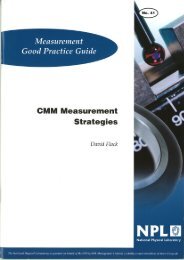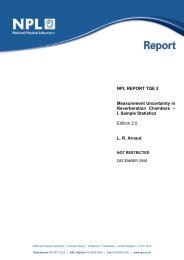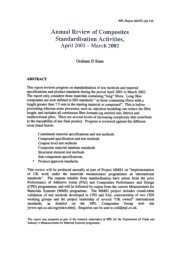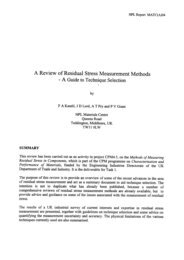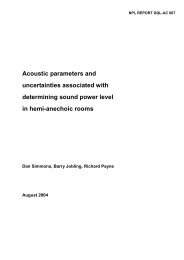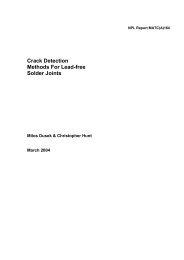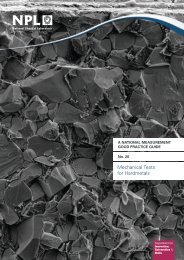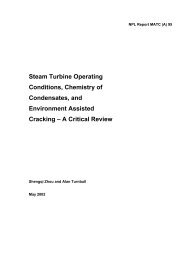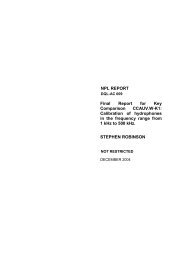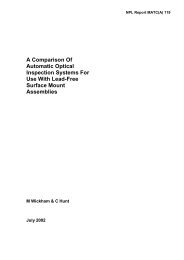Protocol for Establishing and Maintaining the Calibration - NPL ...
Protocol for Establishing and Maintaining the Calibration - NPL ...
Protocol for Establishing and Maintaining the Calibration - NPL ...
Create successful ePaper yourself
Turn your PDF publications into a flip-book with our unique Google optimized e-Paper software.
20 Good Practice Guide 93 Chapter 2<br />
Figure 2.2<br />
Effects of recombination.<br />
Indicated activity/true activity<br />
1.01<br />
1<br />
0.99<br />
0.98<br />
0.97<br />
0.96<br />
0.95<br />
0.94<br />
Calibrator A<br />
Calibrator B<br />
0.01 0.1 1 10 100<br />
Ideal<br />
True activity (GBq)<br />
For most modern calibrators, <strong>the</strong> effects of recombination should be less than 1% when assaying<br />
100 GBq of Tc-99m. The examples shown in Figure 2.2, A <strong>and</strong> B, are, however, real cases that<br />
have previously been observed [18]. Users should check <strong>the</strong> characteristics of <strong>the</strong>ir own system <strong>for</strong><br />
each radionuclide used. The measurement of linearity (Section 1.3.9) can be used to check both this<br />
uncertainty <strong>and</strong> <strong>the</strong> uncertainty due to electronics.<br />
2.5.2 Low activity <strong>and</strong> background<br />
Background radiation levels become important when low activity levels are being assayed. The<br />
background current arises from two sources: natural background, which remains relatively constant,<br />
<strong>and</strong> that due to radioactive sources in <strong>the</strong> local environment. A typical natural background current<br />
<strong>for</strong> an ionisation chamber is of <strong>the</strong> order of 0.1 pA. Taking 51 Cr as a radionuclide which has a<br />
relatively low current response per unit activity, natural background could contribute as much as<br />
8% of <strong>the</strong> chamber current when assaying an activity level of 4 MBq. For <strong>the</strong> same chamber, it can<br />
be shown that a 0.37 MBq 60 Co source at 1 m from an unshielded chamber will cause a current flow<br />
of almost 0.1 pA. In this example <strong>the</strong> combined sources of background radiation would contribute<br />
some 15% of <strong>the</strong> assay reading.<br />
Many radionuclide calibrators are provided with a background compensation facility. Whilst<br />
simplifying <strong>the</strong> user’s task when properly adjusted, this feature can lead to erroneous results if <strong>the</strong><br />
radiation level in <strong>the</strong> local environment changes between background measurements. It is essential<br />
<strong>the</strong>re<strong>for</strong>e to make regular checks on <strong>the</strong> background radiation level.<br />
As pointed out in section 2.4, <strong>the</strong> time period <strong>for</strong> a single measurement may vary depending on <strong>the</strong><br />
current output. There<strong>for</strong>e, if <strong>the</strong> background constitutes a significant proportion of <strong>the</strong> sample<br />
response, it is important to know <strong>the</strong> uncertainty of <strong>the</strong> background measurement. The simplest<br />
means of doing this is to take a series of background measurements at <strong>the</strong> installation stage <strong>and</strong> to<br />
determine <strong>the</strong> st<strong>and</strong>ard deviation of a single measurement. Obviously, if <strong>the</strong> sample being<br />
measured has a low activity, <strong>the</strong> uncertainty arising from <strong>the</strong> background can be reduced by taking<br />
<strong>the</strong> mean of a number of sequential background measurements.



